The Story of Jeremy Burgess
South Australian born Jeremy Burgess is universally regarded as the best crew chief ever in the high-risk, high-speed world of world championship Moto GP racing. Burgess has overseen 14 World Championship victories, been directly accountable for machines and riders that have won 157 MotoGPs and has amassed, by his count, close to 300 podiums. The three mega star riders on his CV, in order, are Wayne Gardner, Mick Doohan and Valentino Rossi.
Burgess, now 72 and retired to his country property at Aldinga in the Adelaide Hills, forms a major part of the latest book Phillip Island: The Inside Story of Australia’s Fastest Racetrack, written by motorsport specialist John Smailes. The tome chronicles almost a century of racing on the circuit rated as the best motorcycle racetrack in the world and, in this edited extract, we take a glimpse into the life and times of Burgess, the Aussie motorcycle racing chief mechanic and the man they call the Rider Whisperer.
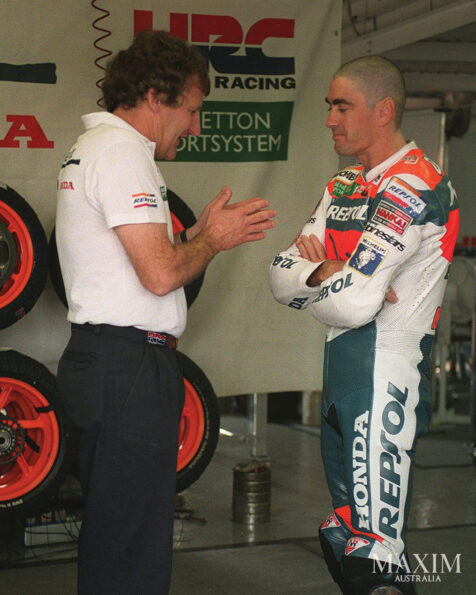
“If I wanted one guy riding for my life, it would be Mick Doohan,” Jeremy Burgess, Honda crew chief throughout Doohan’s Grand Prix career, claimed. It’s a bold statement. Burgess had been seconded to work with the young Gold Coast tearaway Doohan after guiding Australia’s first world motorcycle Champion, Wollongong’s Wayne Gardner through his title year. Jeremy had to be forced to work with Wayne. Nothing against the Wollongong Whiz. “When I went to the UK in 1980, I became a mechanic with the works Suzuki team and then with Honda.
I was Number Two on world champion Freddie Spencer’s bike when Wayne came on board. I said: “I’m perfectly happy where I am.” Then Honda boss Agumi-san got on the phone and said: “If you don’t take the job, you are of no further use to Honda.” OK. Wayne and Jerry (the abbreviation of his name by which he’s known) won the 1987 World Championship, then Mick Doohan joined the team. “Honda wanted me to work with Mick.” Burgess had learned by then not to argue.
Jerry had been an A-grade racer in Australia, not a world beater but better than competent. He knew motorcycle racing as a rider and as a wrench. He preferred wrenching, “although 1986 was the last time I got my hands dirty”. Crew chiefs are like COOs (Chief Operating Officers) in corporations. They take input from above, below and tangentially. They initiate, integrate, delegate, manage, motivate and where necessary manipulate. And while the buck should stop with the big boss, it usually comes to a screeching halt with them.
“You had to pump Wayne up, “he confided. “He was most insecure. When he found out Honda had hired his arch-rival Eddie Lawson to be his and Mick’s third-man teammate, it set him off. Mick on the other hand was a man in a hurry. “I don’t care who gets a Honda as long as I have one,” he said.
For more than a decade the Mick and Jerry show dominated 500c.c. Grand Prix racing. They lived through Doohan’s massive crashes, the worst in 1992 when he almost lost his leg and his life in an Assen hospital. When he partially recovered, Mick’s injured foot couldn’t use the brake, so they improvised, rigging up a thumb operated rear brake lever. “To see him at Sao Paolo when he made his comeback, to see how much weight he’d lost, how his leg looked. Jerry still empathises. “You can share the disappointment, but you can’t feel the pain.”
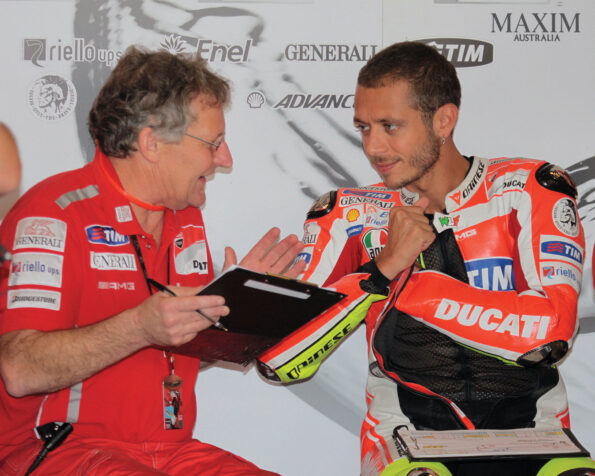
They won five senior world titles together. As far as Jerry was concerned he was with Mick for life. “He’s a man of steel – incredible,” Jerry told me, still in awe. But “It’s a risk industry. You can fall down at any time.” He was with Mick, the hardest and most determined racer of his time, when he won his fifth consecutive 500c.c. World Championship in 1988 at Phillip Island. It was a race for the ages. The year before he’d crashed, leading by seven seconds with only 10 laps to go. “I flicked it into Turn One, hit some bumps and the front folded. I thought I could get it back, so I dug my knee into the tarmac to take the weight off the front tyre. That usually does the trick, but it didn’t this time. Instead, the slide went on forever. You should see the hole in my leathers”, he told the media. Mighty Mick had used his knee to try to stay upright at something north of 280km/h.
In March 1999 Doohan crashed for the last time. It was lap five of practice for the Spanish Grand Prix at Jerez amongst the sherry-vines of Andalusia. He broke his wrist, collarbone and suffered severe muscle damage to his back. The main challenge was another break to the leg he almost lost in ’92.
At the 1999 Australian Grand Prix, Phillip Island honoured him and named Turn One for him. Victorian Premier Jeff Kennett applauded him as he limped, obviously painfully, to his NSR Honda. Organisers had arranged for him to do some parade laps for the crowd. Then he opened the throttles and put down a time that would have qualified midfield for the GP. “I’ve still got the feel for it,” he grinned when he returned to the pits. His mind was ready, but his body was not. He made his retirement announcement at a Gold Coast media conference in mid-December.
And then, along came Valentino Rossi – the GOAT, greatest of all time. “I was sitting in the Honda pit at Phillip Island at 7pm, just me alone,” Jeremy Burgess said. “Valentino walked in, went right up and sat on Mick’s bike, didn’t ask for permission. He didn’t say much, just got to know it.”
In 2000 Rossi, reigning 250c.c. World Champion, was graduating to the 500c.c. division. The mercurial Italian, a talent with a persona that transcended the sport, was in demand. He agreed to join Honda on the proviso they would assign Burgess as crew chief. Had they not, had Doohan kept racing and claimed Burgess, it could have been a deal breaker. “He was the guy making the big step, leaving the comfort of an Italian team (Aprilia) with Italian mechanics to join a Japanese team with Australian mechanics,” Jerry smiled.
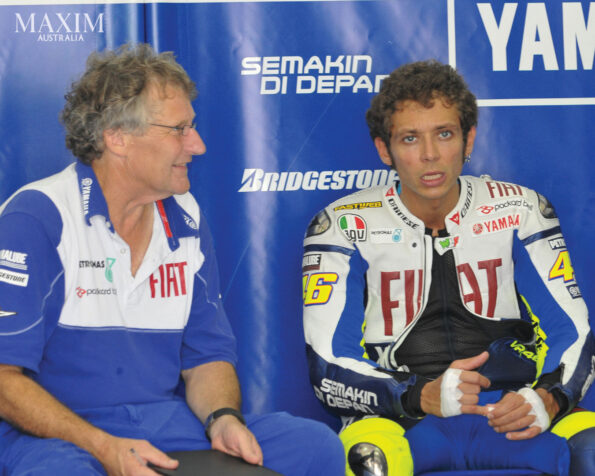
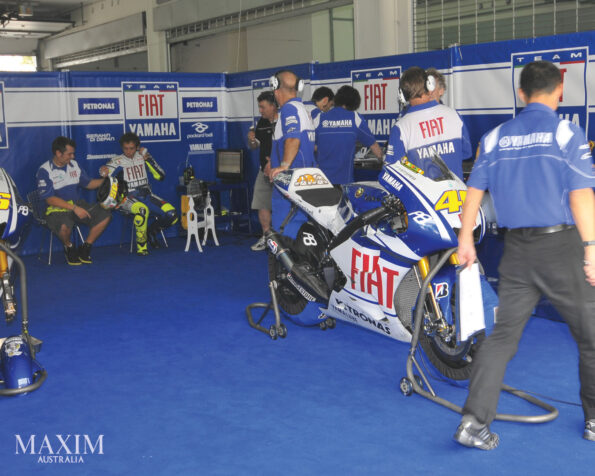
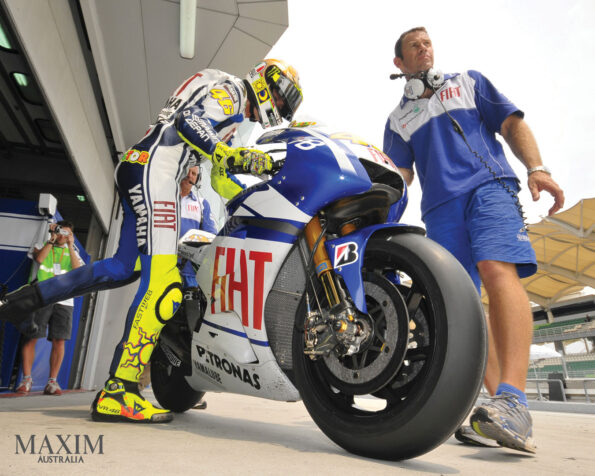
Rossi, Vale to his legions of fans, led a resurgence of excitement in World Motorcycle Grand Prix racing. In 2002 the senior championship regrouped, discarded its screaming two stroke engines and replaced them with howling four strokes. Promoters saw Rossi as the standard bearer for the revival.
With Burgess, Rossi won the last championship of the 500c.c. two stroke era (2001) and the first of the new 990.c. four stroke age (2002). “Someone had to do it,” Burgess quipped. “It might as well be us.” Valentino was a huge talent and a natural showman. Burgess was in a unique position to compare him to Doohan. “While Mick would race to win, and if that was 20 seconds ahead of the next rider so be it, Valentino would race to entertain,” Jerry recalled. “If he knew he had their measure, he’d keep the gap small and at the press conference afterwards he’d talk about how tight it was.”
After enjoying Doohan’s take-no-prisoners determination and long gap victories, Burgess had to learn to live with the new anxiety. Rossi, according to Burgess, had the ability to create magic. “His fan connection was genuine,” Jerry said. “When he celebrated by dressing up as Robin Hood in the UK or pretending to have a toilet stop in Spain, he was for real. Others tried to copy him – like Jorge Lorenzo planting his Lorenzo’s Land flag after a win, but you could see it was contrived.”
“Jerry was like my Dad in MotoGP,” Rossi told me. When Vale and Jerry got together in 2000 there was a bit of sorting out. Rossi wanted a place to sit in the pit garage. “Mick never sat down,” Jerry said, affronted. “‘If you want to sit down, sit on your bike,’” I told him. “He’d come into the pits in practice, and he’d take off his helmet. ‘Don’t do that’, I told him. ‘I want you ready to go back out.’ Rossi agreed to keep his helmet on, but he still wanted a chair. “I sent one of the boys out to buy him one. He liked yellow, so we got it in that colour.”
Rossi’s English, then, was limited. “The language of this garage is English,” Jerry decreed. Even his apanese bosses knew that. “I could see right from the start he was good,” Jerry continued. “The ability of his brain to process information was extraordinary. I liken him to Michael Schumacher.”
Burgess and Rossi agree. His best ever race was at Phillip Island in 2003. “He accidently passed another rider under yellow flags (forbidden) and he was given a 10-second penalty,” Jerry said. “He broke the lap record four times in four laps, made up the lost ground and won by 10 seconds. He told me it’s the only time he’d concentrated 100 percent for the entire race distance. I didn’t breathe for the same time.” For Rossi it was special because: “I push really, really hard and win. I enjoy it very much.”
The Rossi-Burgess combination won five senior World Championships in succession (of their total seven) and claimed five Grand Prix victories at Phillip Island. The first three were on Honda, but the Honda relationship was nearing the end of the line. “Honda believed our bikes were so good anyone could win on them,” Jerry said. “Just the same they gave me the brief to keep him.” Vale told Jerry it wasn’t about the bikes; it wasn’t about the money. It was more than that. It was about respect. He was leaving.
“If it makes any difference, I’ll come with you,” Jerry told his young champion. “I knew I was burning my bridges. “First time out on Yamaha, they won the championship. Then they won another three. Jeremy Burgess and Valentino Rossi dissolved their relationship at the end of the 2013 season. “I was 60 and I didn’t believe Vale could win another championship,” Jeremy said, leaning back in his chair overlooking the rolling landscape of the Adelaide Hills.
The pair had moved to Ducati then quit after a winless 2012 season and moved back to Yamaha, but the results hadn’t come, at least not to their satisfaction. One GP win and a championship fourth was below their expectation.
“I’d signed a one-year contract for 2014, but he said if we’re going to change at the end of next year we may as well change now.” Burgess was half right. Rossi didn’t win another title but he amassed another eight Grand Prix victories and won the Australian Grand Prix in 2014, his sixth, equalling Casey Stoner.
Rossi retired in 2021. Even now his merchandise is still the top selling brand at Phillip Island. Burgess attends each year as an honoured guest.

This is an edited extract from PHILLIP ISLAND by John Smailes (Allen & Unwin, $36.99rrp), available at all good bookstores
By JOHN SMAILES
For the full article grab the April 2025 issue of MAXIM Australia from newsagents and convenience locations. Subscribe here.




